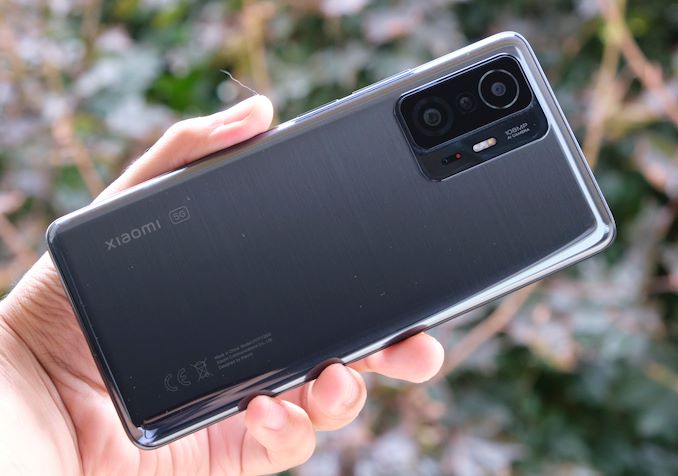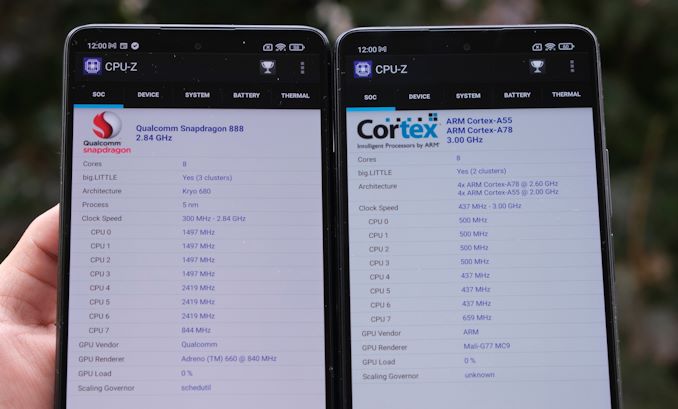The Xiaomi 11T & 11T Pro Review: Two Chips, With a Battery Focus
by Andrei Frumusanu on September 15, 2021 9:00 AM EST- Posted in
- Mobile
- Smartphones
- Xiaomi
- Xiaomi 11T
- Xiaomi 11T Pro
Conclusion & End Remarks
Today’s review was little smaller in scope, notably missing some things such as display evaluation (it’s good), or cameras, however we got the visit the core aspects of the two Xiaomi 11T devices.
The two phones are fundamentally the same, but also couldn’t be any more different in terms of their conclusions;
In terms of design, the devices do market themselves as more budget friendly options compared to the Mi 11. The compromises that were made in design is a blockier form-factor, notably exchanging a curved screen with a lower-resolution flat one, although 120Hz is still there. The build quality of the phones is still good, but not reaching the level of ergonomics we’ve seen on the Mi 11. It’s also in general a larger footprint phone, wider than the Mi 11.
In terms of performance, both phones are good. The 11T Pro, virtue of the Snapdragon 888, is quite snappier and more responsive than the 11T with the MediaTek Dimensity 1200. There are some questionable performance abnormalities for the phones. The 11T Pro handicaps the X1 cores of the Snapdragon quite a bit, and it ends up being unused in a lot of scenarios, notably such as web browsing. The 11T has weird scheduling which also tends to affect its performance to below that of what we expect from the D1200 chip.
On the GPU side, these are the most misbehaving Xiaomi phones to date. In actual gaming titles, performance is ok and thermals are excellent, but Xiaomi only does so in a very opaque manner as there’s very misleading benchmark performance and thermal throttling settings (there’s no throttling!).
Update September 22nd: Following our updated battery test results on the new 11T firmware, we’ve updated the conclusion of the article to better reflect the evaluation of the device.
In terms of battery life, both the 11T and the 11T Pro represent extremely good longevities. Although the SoCs are different, and there are some slight efficiency differences between them, what’s actually more important for the phones is that both devices have optimised platform and display power characteristics that are generally better than other 2021 devices, including Xiaomi’s own other Mi 11 series flagship devices.
Fast-charging has been a PR centre-point for the phones, particularly the 120W 11T Pro. Yes, it’s the fastest charging device on the market, however we are unconvinced of the claims that it doesn’t impact battery longevity. We’ll address the topic in a dedicated article soon, but it’s shocking at how misleading the companies have become in this regard.
The 11T starts at 499€, which really puts the phone at the high end of the mid-tier price category. Thanks to its adequate performance, long battery life, and reasonable compromises, it represents a good value package. The only thing that I would say would have sealed the deal more would be the inclusion of OIS on the main camera, an aspect where both 11T phones still notably struggle behind the Mi 11 or Mi 11i.
The 11T Pro starts at 649€ - it’s a much better device, but its pricing isn’t quite as aggressive as what I had expected from Xiaomi. For only around 50€ more, you can get the Mi 11, which has a much nicer screen, better camera, and although you lose a bit on battery life, it’s a very hard choice to make. There is also the Mi 11i, a phone that is essentially identical to the 11T Pro and comes in at 599€. Xiaomi here is its own toughest competitor in terms of price and value, so I wonder why they felt the need to make the 11T Pro, besides for showcasing 120W charging.
Out of both devices, the 11T Pro is a bit weird because it overlaps so much to Xiaomi’s other phones. The pricing and value of the 11T is something that is able to differentiate itself more, and is a more good overall value package that might interest users.












41 Comments
View All Comments
arayoflight - Wednesday, September 15, 2021 - link
The battery life test of D1200 phone is rather surprising. The OnePlus Nord 2 which uses the same chipset does pretty well in GSMArena's battery test: https://fdn.gsmarena.com/imgroot/reviews/21/oneplu...yeeeeman - Wednesday, September 15, 2021 - link
Yep, I suspect this is a xiaomi thing, not something really bad with the soc, as I would expect mediatek engineer to be able to test power consumption of their soc before releasing it to the market.flipp0 - Thursday, September 16, 2021 - link
Yes, I had the Nord 2 and battery life was great. I think it is likley that anandtech got a faulty 11T unit or that 11T has some kind of software bug draining the battery. I am suprised that Andrei does not mention this a possible explanation for the results reported in this review.Spunjji - Monday, September 20, 2021 - link
Crappy software. Glad to see they fixed it, but that was pretty poor to be releasing a review unit in such a bad state.eastcoast_pete - Wednesday, September 15, 2021 - link
Thanks for the test, especially taking a close look at power management of the SoCs! I guess the overheating issue with the 888 indicates both the appetite of the X1 for power, and the need for good thermal design when used in a close, confined space like a Smartphone. Almost looks as if Xiaomi assumed that designs for older, lower powered SoCs would work just fine with the 888, and was in for a nasty surprise when it didn't.It's too bad that Xiaomi seems to then insist on "improving" these phones with their idea of enhancement by software, which clearly doesn't work. Those results for the Dimensity are also surprising, and not in a good way.
The temperatures measured remind me of an old phone with the SD 808 many years ago; probably the worst SoC QC I ever had the displeasure of owning.
shabby - Wednesday, September 15, 2021 - link
Interesting to see the price difference when the only difference is the soc, Qualcomm sure charges a premium.shabby - Wednesday, September 15, 2021 - link
But ouch that battery life, shirley some software updates might fix this?Spunjji - Monday, September 20, 2021 - link
And they did!PEJUman - Wednesday, September 15, 2021 - link
Curious if Xiaomi is using 'power' cells instead of 'energy' cells on their phones. Or if they are simply pushing energy cells with obscene C rates (at 4V * 4Ah, that's a mere 16 Wh of energy capacity), charging this at 100+ Watts to full is basically 6+ C charging rates.Either they have great battery tech, not sure who is their supplier for these... or the customer will just have to contend with rapid aging of their battery as they fast charge it everyday.
DanNeely - Wednesday, September 15, 2021 - link
Killing batteries early goes right with making battery replacement difficult as a means to drive more sales of new phones.